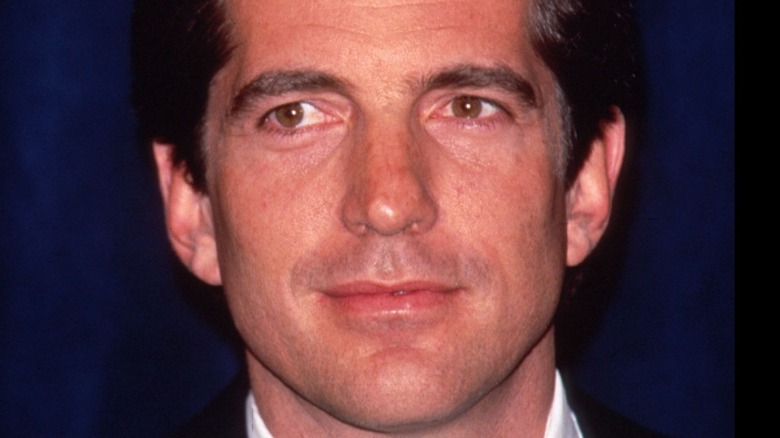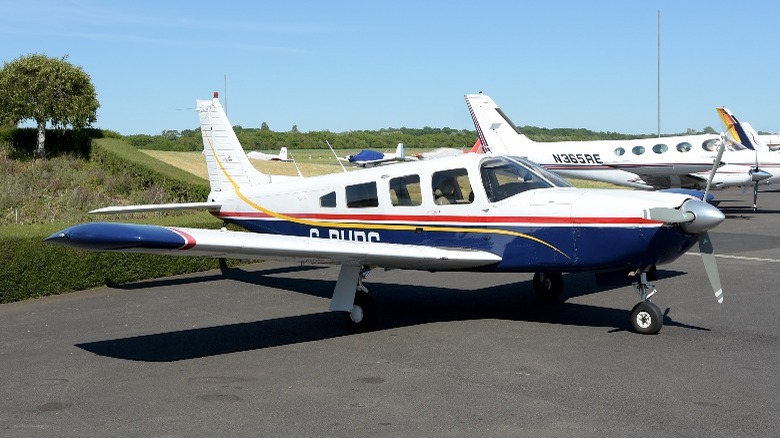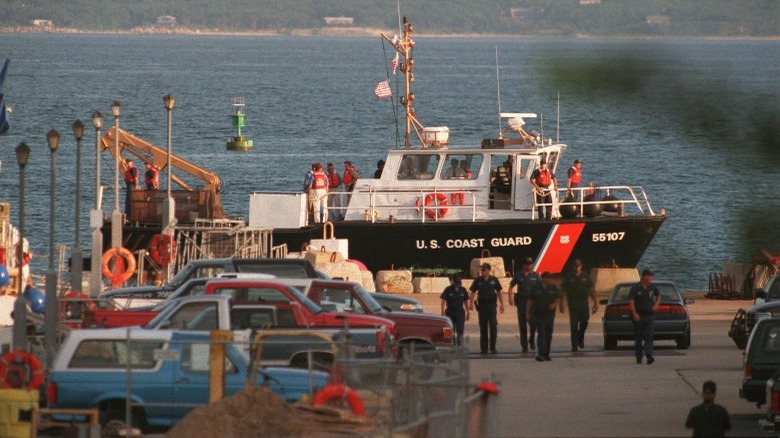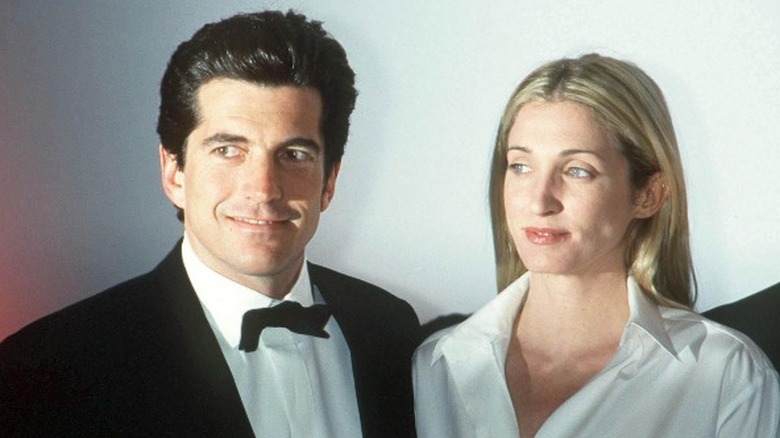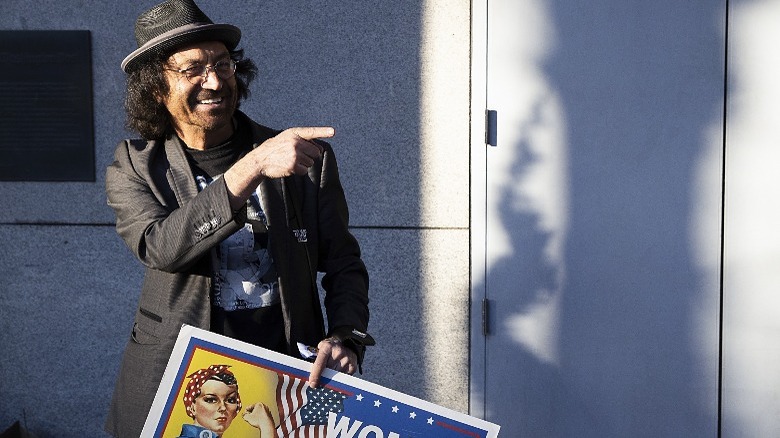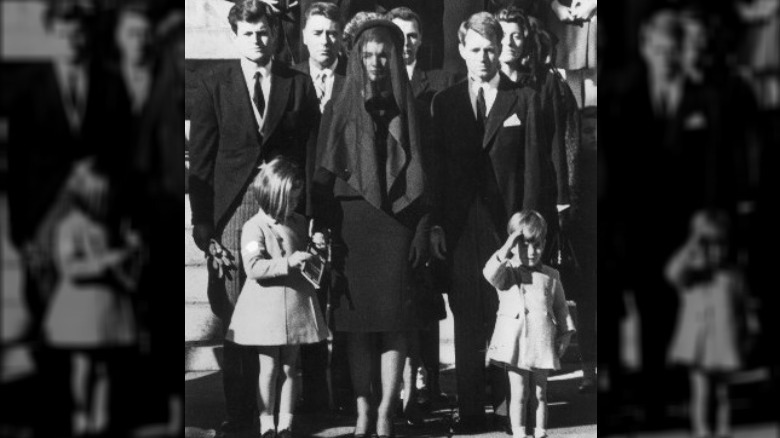The Tragic 1999 Death Of John F. Kennedy Jr. Explained
John F. Kennedy Jr. was born into glamour and fame and seemed poised for a glittering life. But tragedy followed him, starting just before his third birthday, when his father was assassinated, and ending with his own premature death in 1999. Kennedy was born November 25, 1960, just after his father was elected president, but before his inauguration. A photo of him saluting his father's coffin during the funeral in 1963 became iconic, The Washington Post noted. After his father's death, his mother raised him and his sister Caroline in Manhattan (via History). As he grew up, he was able to avoid the kind of scandals that plagued his Kennedy cousins, per The Washington Post. He attended Brown University, then New York University's law school, but it took him three tries to pass the bar exam.
He stayed in the limelight, dating celebrities like Daryl Hannah. Eventually, he married a private citizen, fashion publicist Carolyn Bessette, in 1996 (via History). In the months leading up to their deaths, Bessette struggled to adjust to the public scrutiny she faced as his wife, and according to All That's Interesting, they fought over whether or not to have children.
Like many incidents related to his family, the plane crash that killed Kennedy, Bessette, and her sister Lauren Bessette has been the subject of conspiracy theories. So what really happened that summer night?
Kennedy's flight to Massachusetts
Kennedy had been taking flying lessons for a couple of years and had received his private pilot's license in April 1998, according to InTouch Weekly. He had logged around 300 flight hours but wasn't qualified to fly in every type of situation, History says. Specifically, he hadn't been cleared to fly with instruments only, which is effectively what he did the night of July 16, 1999, as the weather conditions were hazy with low visibility (via The Washington Post). According to History, he turned down a flight instructor's offer to accompany him that night.
He took off from the Essex County Airport in Fairfield, N.J., at 8:38 p.m. He planned to fly to Martha's Vineyard, Mass., about 200 miles away, to drop off Lauren Bessette. He would then continue to Hyannis Port, Massachusetts, with his wife for the wedding of his cousin, Rory Kennedy. They flew in a Piper Saratoga plane he had bought in April, though most of his flying practice had been in a different kind of plane (via The Washington Post).
The trio never made it to Martha's Vineyard. The plane disappeared from radar around 9:30 p.m., after having dropped 1,100 feet in 14 seconds (via History).
The search for the Kennedy-Bessettes
The Kennedys reported the plane missing around 2:15 a.m. on July 17, after they had waited hours for its arrival. The search for the plane began around 7:30 a.m. when the Coast Guard sent out 16 planes, four helicopters, and several cutters to look along the flight route. Rory Kennedy's wedding was postponed, and the family instead spent the day praying together and watching news coverage of the search. That afternoon, searchers began to find debris from the plane, and Lauren Bessette's suitcase washed up on the beach at Gay Head, Massachusetts (via The Washington Post).
After two days, the three passengers were presumed to be dead, but, according to History, the search for their bodies and the plane's wreckage continued. The discovery came on July 21, five days after the crash. Searchers found the plane 116 feet underwater, eight miles off the coast of Martha's Vineyard, and recovered all three bodies from the plane.
The next day, the cremated remains of the three bodies were buried at sea, and on July 23, the Kennedys held a private mass for them at the Church of St. Thomas More in Manhattan, which Jacqueline Kennedy had attended. In his eulogy for John Jr., Senator Ted Kennedy said, "From the first day of his life, John seemed to belong not only to our family, but to the American family. He had a legacy, and he learned to treasure it. He was part of a legend, and he learned to live with it" (via History).
The likely cause of the crash
The National Transportation Safety Board investigated the crash and in 2000 released a report concluding that Kennedy's inexperience as a pilot was to blame for the crash, as he probably became disoriented in the low-visibility conditions (via History). An air crash investigator, Richard Bender, told InTouch Weekly that Kennedy was still having trouble "remembering what instruments he should have been looking at," which could have caused spatial disorientation. In other words, Kennedy might have thought he was in one position while actually being in another.
InTouch Weekly also noted that Kennedy was recovering from an ankle injury at the time of the crash and had gotten his cast off less than 24 hours before. That could have affected his ability to control the plane's rudder foot pedals. However, fellow pilot Kyle Bailey, who was probably the last person to see Kennedy alive, said Kennedy's only lingering issue was a slight limp, so he doesn't think the injury contributed to the crash.
According to All That's Interesting, Kennedy's fellow students at the Flight Safety Academy in Florida, where he had taken lessons, were surprised by the crash. They described him as careful and unlikely to take risks while flying. Comments like these have led many to doubt the official explanation for Kennedy's death.
Conspiracy theories about the crash
Conspiracy theories were already popping up within days of Kennedy's death, as evidenced by an article on the topic published by The Guardian on July 21, 1999. These early theories focused on a "big white flash in the sky" reported by a journalist from the Vineyard Gazette newspaper; they said they had seen it near where the plane disappeared. Some people thought the light was evidence of an alien abduction; others blamed U.S. nuclear testing. According to All That's Interesting, some people believed the crash was suicide — that Kennedy intentionally crashed the plane because of his marital problems and struggles with the magazine "George," of which he was editor-in-chief.
Perhaps the strangest of all theories is a more recent one. Starting around 2017, QAnon theorists began to hypothesize that Kennedy had not actually died in the crash. Instead, his death was faked so that he could secretly help Donald Trump become president. He was expected to emerge from hiding at some point to become Trump's vice president. The theory was based on a "George" magazine interview in which Kennedy mentioned Trump someday becoming president. Some QAnon believers have gone so far as to say that Kennedy is the mysterious Q himself, or that he has taken on the identity of Vincent Fusca (pictured), a Trump supporter who lives in Pittsburgh. Fusca has never responded to questions about this claim (via Yahoo! News).
The Kennedy curse
Still others have tied Kennedy's death to his father's. A reporter who covered the Kennedy family claimed Kennedy was planning to open a new investigation into his father's assassination, which led to the theory that he was killed to prevent this investigation from happening (via All That's Interesting).
More simply, Kennedy's death has been attributed to the infamous "Kennedy curse." The Kennedy curse includes everything from the assassinations of JFK and his younger brother Bobby to the death of Kathleen Kennedy in a plane crash, to latter-day incidents like David Kennedy's drug overdose and Michael Kennedy's fatal ski accident. JFK Jr.'s death came almost 30 years to the day of the Chappaquiddick incident, in which his uncle, Ted Kennedy, was blamed for causing and covering up the death of his campaign aide Mary Jo Kopechne (via The Washington Post).
There is a plethora of theories. Of them all, the simplest and most obvious — that John Jr. was just in over his head as a pilot — is the most widely accepted.
